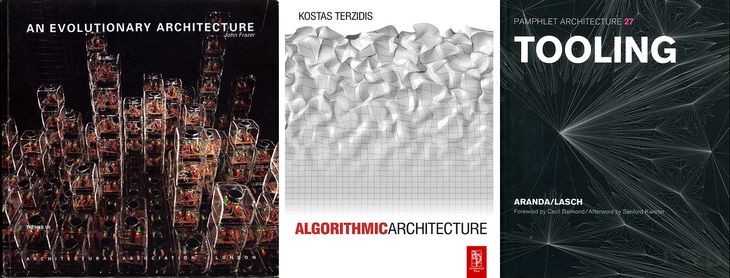I often get emails from people wanting to progress beyond CAD but unsure of where to start. So I started this blog. It seems appropriate to begin with the three books that have guided me and may be a source of inspiration for others.
An Evolutionary Architecture - John Frazer - 1995
This book is remarkable. Written in 1995, Frazer and Unit 11 at the AA, identify many of the issues that are still present in evolutionary architecture. The most pertinent of these is the use of biology as a design analogy, a method which is at the foundation of modern digital morphogenesis. He identifies most of the modern methods like Genetic Algorithms, Neural Networks and Cellular Automata, even though in 1995 they are still new to computer science let alone architecture. Frazer's position is strengthened by his awareness of the limitations of these methods - restraint that some modern authors could benefit from. Some gems of wisdom that are still relevant today:
- 18: Computers "induce a false sense of having optimised a design which may be fundamentally ill conceived."
- 15: "Unfortunately for this goal directed approach, it is notoriously difficult to describe architecture in these terms" - this remains true today.
- 117: "The gap of complexity that exists between unsimulatable real world systems and our models of them reflects the fact that the real world often behaves in ways that directly contradict our ideas about it."
The book is made available by the AA for download as a pdf here - a few months ago the book was taken down but it appears to be back up.
Algorithmic Architecture - Kostas Terzidis - 2006
Terzidis advocates a symbiotic relationship between algorithms and human designers, best summarised by this quote: "Human designers fail to compute extreme quantitative complexity and computational processes fail to justify consciously even simple decisions" (29). At times I feel Terzidis falls for etymology and clouds the book with discussions of words rather than words themselves. This is probably a product of his circumstance and underneath this there is a great thesis. The book ends with programming examples in MEL script (for Maya). He has also just finished a new book Algorithms for Visual Design Using the Processing Language I have not had a chance to read it, but it looks really good.
There is currently a preview on Google books.
Tooling - Benjamin Aranda, Chris Lasch - 2005
Tooling is not my favourite book but I added it because it is a great introduction. The book goes through seven simple algorithms, all explained by excellent diagrams, and developed into architectural projects. Programming begs for more complexity and it is refreshing to see the authors keep everything so simple. In this simplicity there is an argument for programming as a method of sketching. I feel that it is somewhat misleading to present seven very considered projects as sketches - I do not believe the genesis for these projects was the code. Nevertheless, they provide a relevant introduction to programming.
There is also a preview of Tooling on Google Books.
